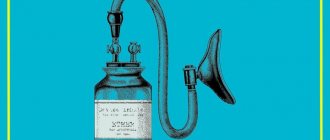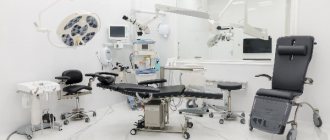Medicine has been developing at an accelerated pace for many centuries. Many years ago, the question of surgical intervention was equated with the death of the patient. Now surgery is not only a development in medicine, but also a chance for millions of people to receive the necessary help that conventional drugs can no longer provide. Endotracheal anesthesia (ETN)
The most
important element in surgical intervention is undoubtedly anesthesia, which should ensure comfort and safety for both the patient and the doctors operating him.
Over the years of studying various methods of anesthesia, doctors around the world have achieved incredible heights in their field. One of the advances is endotracheal anesthesia (ETN) . This is a type of anesthesia that provides anesthesia by injecting a narcotic substance through a special tube into the trachea. ETN is indispensable for operations on the heart, lungs, alimentary tract, and nervous system. It can be used for severe patients of all ages.
What is endotracheal anesthesia
Endotracheal anesthesia is the most common type of anesthesia, which is achieved by introducing volatile liquids or gases of a narcotic nature into the human body through an endotracheal tube.
Inhalational anesthetics pass from the respiratory tract into the circulatory system. Next, they are uniformly distributed in human organs and removed through diffusion laws.
The effectiveness of painkillers, the duration of anesthesia and the speed of return to wakefulness depend on many indicators:
- partial pressure;
- lung ventilation volume;
- diffusion capacity of the lungs;
- alveolivenous pressure difference of a single component of the gas mixture;
- penetration of blood cells into tissues and organs;
- volume of blood flow in the lungs;
- human blood circulation.
There are certain requirements for drugs acting as anesthetics for endotracheal anesthesia.
These include the presence of:
- reserve, which is a source of oxygen;
- alarm warning of a decrease in oxygen pressure;
- a blocker that helps stop the flow of nitric oxide when oxygen pressure decreases;
- antiseptics;
- the ability to disassemble the breathing circuit;
- safety of use of medical equipment for patients and doctors.
Modern technology for performing endotracheal anesthesia consists of the following components:
- a high-pressure system (it supplies compressed medical gases to the main components of the device);
- dosimeters that provide gradual dosing of oxygen and nitric oxide;
- evaporators of volatile narcotic substances (necessary for the formation of a combination of gas anesthetics and oxygen);
- a breathing circuit that guarantees the supply of narcotic drugs to the patient and the removal from him (consists of recirculation valves, an adsorber, connection elements and special hoses for breathing);
- devices for artificial lung ventilation;
- control and measuring devices;
- laryngoscope;
- endotracheal tube.
Droperidol: instructions
Droperidol is an antipsychotic drug often used during endotracheal anesthesia. According to the chemical structure, this substance is a tertiary amine. It has a sedative effect within 3 minutes after administration. Blocks dopamine receptors, which causes neurovegetative inhibition. In addition, it has antiemetic and hypothermic effects. The effect on breathing is slight.
Prescribed for premedication, induction of anesthesia, myocardial infarction, shock, severe angina, pulmonary edema and hypertensive crisis. Recommended as a drug that eliminates nausea and vomiting. It has low toxicity, which allows its use in pediatric surgery and obstetrics.
Advantages and disadvantages
Endotracheal anesthesia is a serious and responsible undertaking. Before surgery, it is important to familiarize yourself with all its pros and cons.
| Advantages | Flaws |
| Increased controllability (you can easily vary the depth of anesthesia, increase the duration of anesthesia, and also facilitate immediate awakening of the patient) | The dosage of painkillers is carried out inaccurately (most often using old equipment) |
| It is possible to combine painkillers with the process of artificial ventilation of the lungs | Frequent contamination of the operating room air with vapors of anesthetic drugs during different operating modes of anesthesia equipment (except for a closed circuit) |
| Excellent combination of drugs required for general anesthesia | To obtain the expected result, complex medical equipment is required, which is expensive. |
| Total muscle relaxation (facilitates the process of long-term surgery on the abdominal and chest organs) | The procedure requires strict sanitization (if carried out incorrectly, it contributes to the spread of pathogenic microorganisms inside the hospital) |
| The separation of the respiratory and digestive systems is carried out using an endotracheal tube (this ensures the prevention of aspiration of stomach contents) | When clearing the trachea of accumulated fluid, damage to the mucous membrane of the oropharynx, tongue, hard and soft palate, damage to teeth and vocal cords may occur. |
| It is always possible to clear the trachea of accumulated fluid through an endotracheal tube | Incorrect placement of the endotracheal tube often leads to intubation of the right bronchus and esophagus |
| Small amounts of drugs are used | After surgery, airway patency and recurarization are impaired |
Intubation
After depression of consciousness, artificial ventilation of the lungs is performed with oxygen using an anesthesia mask. After which the doctor performs intubation through the mouth (less often through the nose). The head is thrown back, the mouth is opened. A laryngoscope with a straight blade is inserted along the midline between the palate and the tongue, pressing the latter upward. Moving the instrument further, the apex of the epiglottis is lifted. The glottis is shown, into which the endotracheal tube is inserted. It should extend into the trachea by about 2-3 cm. After successful intubation, the tube is fixed and the patient is connected to mechanical ventilation.
A laryngoscope with a curved blade is less commonly used. It is inserted between the base of the epiglottis and the root of the tongue, pushing the latter upward away from itself. If it is impossible to insert the tube through the mouth, use the lower nasal passage. For example, surgery is performed to remove an oral cyst.
How to do it step by step
The sequence of endotracheal anesthesia:
- Immersion in anesthesia is carried out by administering painkillers necessary to obtain deep anesthesia sleep without an exciting stage; modern barbiturates, fentonyl and promedol are used in combination with sombrevin. After administration of the medication, muscle relaxants are used, tracheal intubation is performed, then the patient is transferred to artificial ventilation to prevent normal gas exchange during surgery.
- Maintenance of anesthesia - a period that lasts throughout the entire operation. The main goal is to achieve the necessary components of anesthesia care and the environment for an experienced specialist to work. The human body is protected from operational risks. Anesthesia is maintained at 1 level of surgery. Its main stage is achieved with a mixture of nitrogen oxide and oxygen in a 2:1 ratio, halothane, and cyclopropane. Muscle relaxants are often used to reduce muscle tone. The main condition for endotracheal anesthesia is artificial ventilation of the lungs. Neuroleptics are administered in small portions - fentanyl and droperidol, 1-2 ml each, over 10-25 minutes. The anesthesiologist must intelligently manage the components of anesthesia and the body's abilities.
The figure shows how the procedure for administering endotracheal anesthesia is performed. - Awakening - the restoration of the previous functions of the human body begins at the moment when the anesthesiologist stops administering narcotic drugs. General anesthesia ends long before the invasion stops. First, specialists remove components of anesthesia that are no longer needed. Next, the final stitches are applied. The patient is sent to the recovery room and his health continues to be monitored.
Tracheostomy technique
Tracheostomy placement is performed using a tracheostomy instrument kit. It includes a general surgical set (scalpels, hooks, forceps, hemostatic clamps) and special instruments (sharp single-prong Chassaignac hook, blunt single-blade L-shaped Kocher hook, Trousseau tracheal dilator and tracheostomy cannulas).
Tracheostomy is performed under local anesthesia or endobronchial anesthesia. If emergency assistance is provided, the operation can be performed without pain relief. When performing an upper tracheostomy, a vertical incision 6-7 cm long is made strictly along the midline. The skin, subcutaneous tissue and superficial fascia of the neck are incised from the middle of the thyroid cartilage. When performing a transverse tracheostomy, the incision is made at the level of the cricoid cartilage.
After this, the surgeon dissects the linea alba of the neck, the intracervical fascia. The isthmus of the thyroid gland is disconnected from the trachea and pushed downwards. Then, with a single-pronged hook, the larynx is fixed and the cartilages of the larynx are cut. After this, a tube is inserted into the trachea and its patency is checked. The fascia is tightly sutured around the tube and sparse sutures are placed on the skin. The operating nurse secures the tube around the neck with a bandage. When performing a lower tracheostomy, the stages of the operation are the same. The difference between this type of operation and the previous one is the location of the incision. It is performed between the fourth and fifth cartilaginous rings of the trachea.
A special type of tracheostomy is tracheocentesis - percutaneous puncture tracheostomy. It is performed with a thick surgical needle along the midline of the neck under the thyroid cartilage. Percutaneous microtracheostomy is performed by an anesthesiologist at the patient's bedside. The procedure does not require transfer of the patient to the operating room.
Percutaneous tracheostomy has the following advantages over the traditional technique:
- simple execution technique;
- performed under local anesthesia;
- not accompanied by vascular damage;
- low risk of developing infectious complications;
- minimal incidence of stenosis after the procedure.
The small and neat hole after dilation tracheostomy is closed with a less rough scar. When a tracheostomy is performed, the operation protocol is recorded in a special journal.
Specifics of implementation in children
Endotracheal anesthesia in children is a more complex process. The most important difference between adults and children is the amount of oxygen consumed, which is almost 2 times more in minors. In children, mucus secretion in the respiratory tract is increased. Experts also note the presence of narrow nasal passages and a large tongue.
Due to the fact that the larynx is located too high and the epiglottis has large volumes, when intubating the trachea, it is advisable to use a straight blade that will help raise the epiglottis.
The size of the endotracheal tube is of great importance, since the mucous membranes in children are very delicate, and a large-diameter device can affect the development of postintubation edema with tracheal obstruction after extubation.
To perform an operation on children 10-11 years old, it is necessary to use a tube without a lapel with a slight leak of gas flow around it; during ventilation, it is mandatory. It is important to know that the water-salt balance in minors is variable. This is due to daily changes in body weight, cell and tissue structure.
The kidneys are underdeveloped, so children do not tolerate water loads well and quickly remove electrolytes. It is important to maintain fluid infusions during operations with low blood loss. The process is calculated depending on the child’s body weight: 4 ml/kg per 10 kg + 2 ml/kg per 10 kg. Further 1 ml/kg for each kg above 20 kg. Maintenance therapy helps replace the fluid the baby needs.
After surgery, it is recommended to drink a lot of clean water to replenish fluid deficiency on your own. In a hot operating room, babies can overheat if their body temperature was elevated before the infection. Hyperthermia often develops as a result of the administration of atropine. The dosage of drugs in children also differs.
More often, anesthesiologists are guided by the following principle:
- for newborns – 1/10 of the adult dose;
- from 1 to 6 months. – 1/5 dose;
- 7 – 12 months – 1/4 dose;
- from 1 year to 3 years – 1/3 of the adult dose;
- from 4 to 7 years – 1/2 dose;
- from 8 to 12 years – 2/3 of the adult dose.
Indications and contraindications
Indications for endotracheal (intubation) anesthesia are:
- performing surgical interventions on the chest organs, accompanied by surgical accumulation of air or gases in the pleural cavity;
- poor conductivity of the respiratory system channels;
- irritable bowel syndrome;
- risk of aspiration of gastric contents into the respiratory tract;
- risk of rapid movement of liquids or gases in a direction opposite to normal;
- operations on the abdominal organs;
- difficulty breathing due to a certain position on the table;
- the likelihood of using muscle relaxants and artificial ventilation with intermittent positive pressure during the surgical process;
- surgical interventions performed on the facial skeleton and head (often used in cosmetology centers for plastic surgery);
- intranasal and ophthalmic invasions;
- treatment of the thyroid gland, upper ear, sinusitis (in this case, endotracheal anesthesia ensures the obstruction of blood and other biological fluids into the respiratory tract);
- operations aimed at treating intracranial diseases;
- dental treatment;
- long processes requiring the presence of microsurgical medical equipment;
- tendency to laryngospasms;
- frequent disruptions in the central nervous system.
But there are situations when this method of anesthesia is contraindicated.
These include:
- chronic diseases of the upper respiratory tract;
- inflammation of the bronchi;
- acute respiratory viral infections;
- hemorrhagic hemostasiopathies;
- pneumonia;
- malignant tumors of the oral cavity (there is a risk of cancer cells spreading throughout the body, so such people can only undergo endotracheal anesthesia through a tracheostomy);
- problems with the cardiovascular system;
- cachexia;
- anemia;
- old age;
- pregnancy;
- severe damage to the liver and kidneys (anesthesia will cause additional intoxication and distort the patient’s body’s response to anesthetics and their breakdown products).
Consequences and complications
Endotracheal anesthesia is an event during which adverse reactions, negative consequences and other complications rarely occur. More often they are associated with serious conditions of patients or medical errors. Every step of this anesthesia is potentially dangerous in terms of complications.
During water anesthesia and intubation, the following may occur:
- the impossibility of inserting an endotracheal tube into the trachea to ensure conduction of the respiratory tract due to technical reasons;
- asphyxia due to regurgitation of stomach contents into the respiratory system;
- severe pneumonia;
- damage to the laryngopharynx and a kind of continuation of the larynx - the trachea;
- improper bending of the endotracheal tube;
- sudden limitation of the available space in the respiratory tract, which leads to the impossibility of artificial ventilation of the lungs;
- lung rupture;
- inadequate oxygenation of the patient's body.
When anesthesiologists maintain anesthesia, the following may occur:
- disruption of the heart (up to cardiac arrest and further death);
- left ventricular failure;
- oxygen starvation;
- violation of the conductivity of the gas mixture;
- hemodynamic disturbances (drop in blood pressure);
- large blood loss;
- overdose of narcotic medications;
- pain shock (occurs when doctors violate instructions on the use of narcotic drugs);
- premature removal of the endotracheal tube in combination with insufficient monitoring of the patient (often leading to suffocation).
It is important to remember that during surgery the patient must be closely monitored and vital signs measured. Only timely measures can protect a person from complications. Fortunately, they happen very rarely!
The best drugs
Endotracheal anesthesia is a well-known type of anesthesia.
Modern inhalational anesthetics include:
- Sevoflurane is a new generation pain reliever. Has a pleasant smell. Causes rapid loss of consciousness due to the fact that it dissolves poorly in the blood. Often causes muscle relaxation. In some conditions it exhibits nephrotoxicity. Cost about 10,500 rubles. for 250 ml of liquid;
- Desflurane is a medicine similar to Isoflurane. Requires the use of special evaporators. It is poorly soluble in blood, so anesthesia occurs quickly. Used in bariatric surgery. Price about 12,400 rubles. for 240 ml;
- Isoflurane – the product is similar to Ftorotan. Has a pungent ether smell. It is not recommended to use it for operating on patients with coronary artery disease. Affects a decrease in the metabolic needs of the brain. Can be used for cerebroprotection in neurosurgery. The price of the medicine ranges from 5600 to 6700 rubles. for 250 ml;
- Ftorotan (halothane) is a well-known drug that contains halogen. Has a narrow therapeutic effect. Excellent for children with obstruction and reduced minute ventilation. It has a pleasant smell and does not irritate the respiratory tract. This is a very toxic product. After surgery, liver dysfunction and other pathologies may occur. Approximate cost – about 400 rubles. for 50 ml of liquid;
- Enflurane (ethrane) is a medicine that quickly induces general anesthesia. It is capable of inhibiting the functioning of the central nervous system, increasing the sensitivity of the myocardium to sympathomimetics and relaxing the skeletal muscles. Excreted by the lungs. Often used in obstetrics - during caesarean section. Enflurane can only be used using an anesthesia machine with a special evaporator.
Risks of structural notes
Owning investment notes involves taking on a number of risks:
- Firstly, the risk of a decrease in the value of the shares included in the note . If the note contains a basket of shares, then a decline in at least one of them is sufficient for the option not to be exercised and the investor to lose the right to receive additional profit. If an investor bets that an asset will fall, the risk is an increase in value.
- Secondly, the risk of non-payment of the coupon . For Russian structured notes, the issuer may not pay the coupon if the conditions do not match (and sometimes the coupon is “remembered” and paid later).
- Thirdly, the risk of early withdrawal . If the note is non-exchange, then it can only be sold to the bank or broker that issued the paper, and at a cost significantly lower than its face value.
- Finally, the last risk is the risk of bankruptcy of the issuer . In addition, the bank can write off its structural notes as part of additional capitalization (as “junior” debt).
Reviews from doctors and specialists
- Dmitry Agapov is an anesthesiologist. He believes that endotracheal anesthesia has little effect on the condition and functioning of internal organs and provides a controlled effect. This type of anesthesia is well suited for operating on young children. They inhale the anesthetic inhalation mixture through a mask and fall asleep without problems.
- Ekaterina Smirnova is an anesthesiologist who recommends endotracheal anesthesia to turn off the patient’s consciousness. He will not feel pain, the muscles will completely relax. After surgery, there is no memory of it at all.
- Experienced specialist Irina Lapshina believes that endotracheal anesthesia is the most powerful type of anesthesia, making the sick person completely immune to external stimuli. A combination of medications used in general anesthesia prevents the sensation of pain. They immobilize the patient during the procedure.
Endotracheal (intubation) anesthesia is the forced immersion of a sick person into a medicated sleep. It is only important before the operation to carefully study the information about this type of anesthesia, consult with your doctor and take the necessary tests to prevent the development of complications.
Author: Timokhina Angelina











